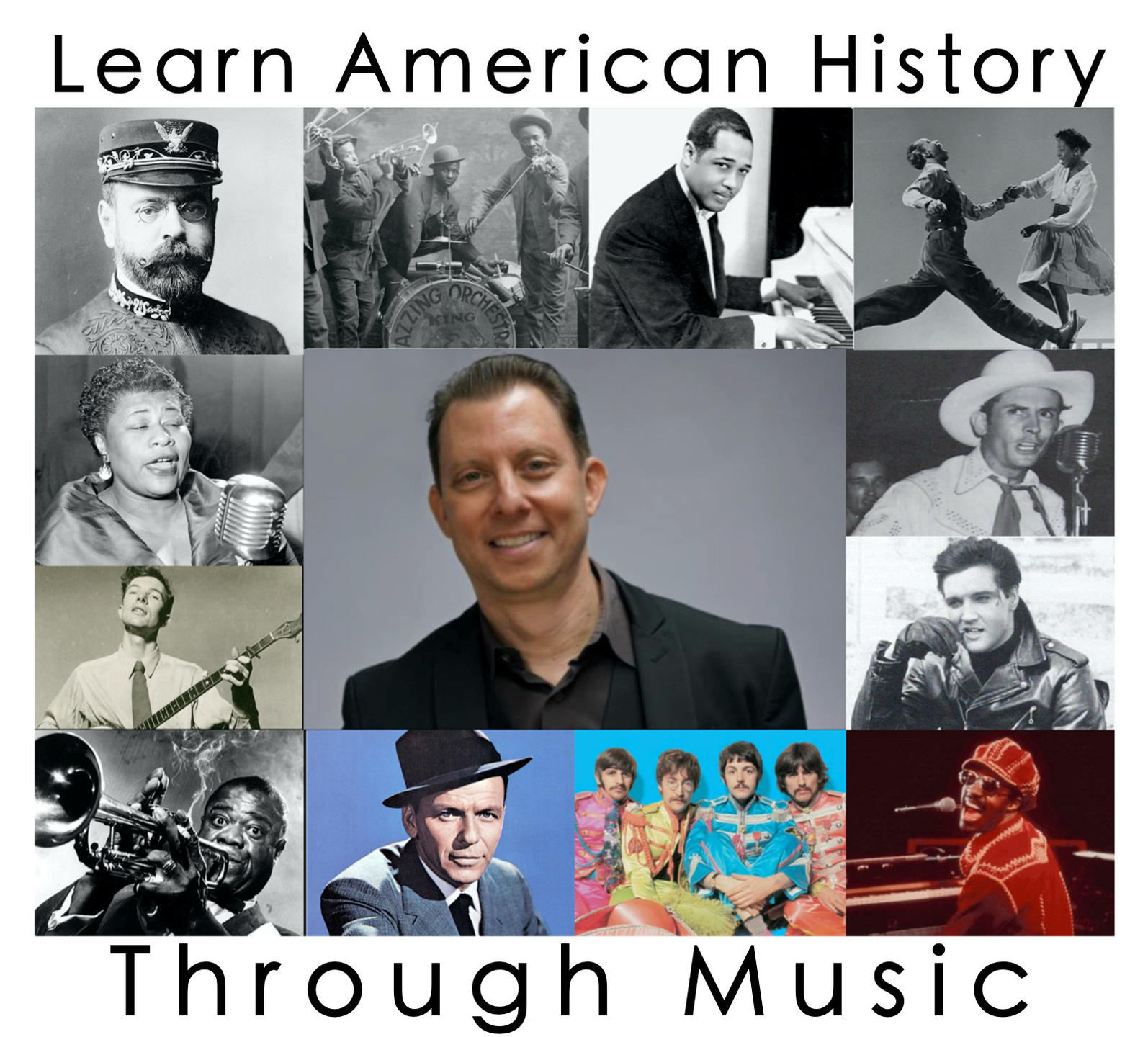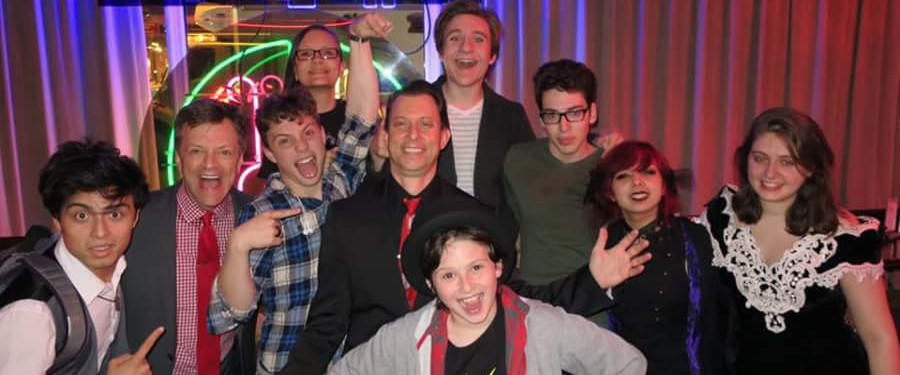Learning History Through Music
An Online Homeschool Course with Daniel Glass

"If your child loves music, 'Learning History Through Music' offers a fun, engaging and highly interactive way to learn about U.S. History through the development of popular music."
Course Details: Next Course Starts Fall, 2024
This online course spans a full academic year and is divided into two semesters (Fall and Spring). Students must enroll in both semesters to be accepted into the course. The cost is $750 for both semesters, which is broken down into 32 75-min. sessions ($18.75/hr).
Class Size: Minimum of 10 - Maximum of 15 (allowing for plenty of interaction and conversation).
Location: Course lectures will be held remotely via Zoom.
Times: Mondays and Wednesdays, 12:00 - 1:15 pm Eastern time.
Recording: All sessions will be recorded and archived, so if your child has a conflict with one or both of the weekly times, they will still be able to take the course and participate in the assignments.
Ages: 12 to 17 (with some exceptions made for mature 11 year olds).
Prior Experience: No music education or experience required, but an interest in music is a plus!
Fall 2024 Dates:
- September: 16, 18, 23, 25, 30
- October: 2, 21, 23, 28, 30
- November: 11, 13, 18, 20, 25, 27
Spring 2025 Dates:
- TBA
Questions: Email Daniel directly.
Course Description:
If your child loves music, Learning History Through Music offers a fun, engaging and highly interactive way to learn about the history of the United States through the development of popular music. Led by award-winning New York jazz musician, author and educator Daniel Glass, the course takes students on a thrilling journey that spans more than 100 years, starting at the time of the Civil War (1865), and moving through the eras of ragtime, jazz, big band swing, bebop, rhythm and blues, country, rock’n’roll and into more modern styles like funk, metal and hip hop.
Check out a more detailed outline below, as well as a video excerpt from the course, parent/student testimonials, and additional information about Daniel Glass.
The course illustrates how American Popular Music evolved alongside important historical, economic and sociological events such as Slavery, Segregation, Prohibition, Immigration, the Great Depression, World War II, the Cold War, the Civil Rights Movement, the rise of the teenager, the Counter-Culture, Vietnam, and much more. One unit is dedicated entirely to the Great American Songbook, and another to American Civics.
Each class incorporates video footage, photographs and other graphics that bring the material to life. Students are encouraged to share their viewpoint about the subject matter. The entire course is designed to fully engage students, and help them understand their world in a much broader context.
Optional written assignments are available for each unit.
Grades provided upon request.
Here's a video excerpt from Unit 4, which focuses on Prohibition and the rise of jazz in United States in the years following World War I
Testimonials

"Daniel … you have our heartfelt gratitude for getting our daughter Isabelle excited about history again."
Angie P. (Parent)
"Daniel Glass is a walking encyclopedia of musical and historical knowledge. He makes history class interesting and easily relatable through his analysis of the music of each period. This guy is the best and I can’t wait for his next class!"
Bryce E. (Student, 15 y/o)
"Dear Mr. Glass,
Thank you so much for your class this year. I have learned a lot, and you did a great job of squeezing so much info in each short class. I really enjoyed learning about so many styles of music, and the history was very interesting too. I’m looking forward to your Musical Personalities class next year!"
Mia B. (Student, 13 y/o)
"It has been a pleasure taking your class, and I've learned more than I ever thought I would before 11th grade, much less 7th. It's been amazing to look at history from all sides, whether through the eyes of a child migrating to California out of the Dust Bowl, a soldier getting heli-vacced out of Saigon, or someone attending a Minton's playhouse jam session. Thank you for a wonderful year!"
Ryan C. (Student, 12 y/o)
Semester 1
Week 1: America in the time of the Civil War (1865-1880). A divided country, "manifest destiny," trans-Atlantic slave trade, Civil War, military music, European styles, folk music, African-American musical origins and influences (gospel music, tap dancing, call and response).
Week 2: Brass Bands and Ragtime (1880-1900) Emancipation proclamation, reconstruction, post-war musical landscape, John Philip Sousa, ragtime, minstrelsy, the birth of the blues.
Week 3: Early Jazz (1900-1919). New Orleans, Congo Square, “Second-Line” rhythms, jazz music and dance, Vernon and Irene Castle, James Reese Europe, WWI, Flu Pandemic.
Week 4: The Roaring Twenties (1919-1929). Prohibition, spread of jazz to Chicago and NYC, Louis Armstrong, women's suffrage, blues singers, Duke Ellington, Harlem Renaissance.
Week 5: Great American Songbook (1920s-1960s). Tin Pan Alley, songwriters and publishers, song forms, famous crooners and songbirds, the role of Hollywood.
Week 6: The Great Depression (1929-1939). Stock Market crash, the “dust bowl,” Woody Guthrie, folk music as social justice, rise of radio, big band swing, Count Basie, Savoy Ballroom, Frank Sinatra.
Week 7: World War II (1939-1945). World at war, influence of the big bands, boogie-woogie, shuffles, Lionel Hampton, Sister Rosetta Tharpe.
Week 8: Bebop Jazz (1942-1955). Segregation, jazz as a “conversation,” evolution of bebop in Harlem, jazz as a political statement, Charlie Parker, Dizzy Gillespie, scat singing.
Semester 2
Week 1: American Civics: Three branches of government, the constitution, the bill of right, elections, separation of powers, checks and balances.
Week 2: Rhythm and Blues (1942-1960). The blues as an “oral tradition,” W.C. Handy, Gospel music, the Great Migration, Louis Jordan, evolution of rhythm and blues.
Week 3: Country Music and Rockabilly (1945-1955). Nashville, Grand Ole’ Opry, Hank Williams, Sun Records, Sam Phillips, Carl Perkins, Johnny Cash.
Week 4: The 1950s, Part 1.
Suburbia, Baby Boom Generation, the American Dream, and the Cold War. Evolution of jazz, folk revival.
Week 5: The 1950s, Part 2.
The rise of Rock’n’Roll, the Civil Rights Movement, and the Counterculture. Rise of the teenager, Elvis Presley, Bill Haley, Chuck Berry.
Week 6: The 1960s, Part 1. Civil Rights, Martin Luther King, JFK, Vietnam, Bob Dylan, soul music, Ray Charles, James Brown, instrumental rock.
Week 7: The 1960s, Part 2. The British Invasion, influence of the Beatles, hippies/counter-culture, black power, student activism, Woodstock.
Week 8: The 1970s. End of Vietnam, Watergate, the Women's movement, energy crisis, Middle East conflict, environmental movement, Chicano/Native American rights, glam, heavy metal, disco, the rise of punk and hip-hop.
About Daniel Glass


